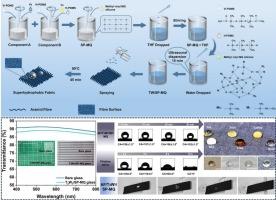A novel fluorine/nanoparticle-free self-roughened organosilicon finishing agent with robust durability: toward superhydrophobic restoration and anti-icing of firefighting suit
IF 7.3
2区 材料科学
Q1 CHEMISTRY, APPLIED
引用次数: 0
Abstract
The hydrophobicity of firefighting suit is crucial as it effectively blocks liquid-phase hazards (water/chemicals), maintains wear comfort, and enhances durability and safety by preventing water penetration, essential for firefighters' operational reliability in harsh environments like cold conditions. However, the preparation of abrasion resistant and transparent superhydrophobic coating without fluorine/nanoparticle by environmentally friendly methods is still a major challenge. In this study, a highly abrasion resistant silicone polymer was synthesized by vinyl-terminated polydimethylsiloxane, hydride-terminated polydimethylsiloxane, and methyl vinyl MQ silicone resin. Through solvent-induced phase separation, the silicone polymer could be stably dispersed in the phase-separated system at micro/nano scales. Systematic optimization of the solvent (tetrahydrofuran) to non-solvent (deionized water) ratio yielded a water-rich organosilicon finishing agent capable of spontaneously forming micro/nanoscale rough surfaces following a mild curing temperature. The cured organosilicon finishing agent showed highly transparency with a transmittance reaching 88 %. The aramid fabric after being coated by organosilicon finishing agent showed excellent superhydrophobicity with contact angle of 159° and sliding angle of 5.5°. After 10 standard washing cycles, 400 cycles of sandpaper abrasion, and 24 h acid, alkali, and salt immersion, it still retains its superhydrophobicity with a contact angle greater than 150°. Notably, the finished aramid fabric maintains nearly unchanged breathability and flexibility while exhibiting exceptional anti-icing properties. These characteristics significantly enhance the operational efficiency and safety for firefighters in northern cold regions. The preparation of environmentally friendly superhydrophobic organosilicon finishing agent demonstrates large-scale production potential and shows promising application prospects in high-end textiles and specialized protective equipments.

一种新型无氟/纳米颗粒自粗化有机硅整理剂,具有强大的耐久性:用于消防服的超疏水修复和防结冰
消防服的疏水性至关重要,因为它可以有效地阻挡液相危害(水/化学品),保持穿着舒适性,并通过防止水渗透来提高耐久性和安全性,这对于消防员在寒冷条件等恶劣环境下的操作可靠性至关重要。然而,如何用环保的方法制备无氟/纳米颗粒的耐磨透明超疏水涂层仍然是一个重大挑战。本研究以端乙烯基聚二甲基硅氧烷、端氢化物聚二甲基硅氧烷和甲基乙烯基MQ有机硅树脂为原料合成了一种高耐磨性的有机硅聚合物。通过溶剂诱导相分离,有机硅聚合物可以在微纳尺度上稳定地分散在相分离体系中。系统优化溶剂(四氢呋喃)与非溶剂(去离子水)的比例,得到一种富水有机硅整理剂,在温和的固化温度下,能够自发形成微/纳米级粗糙表面。固化后的有机硅整理剂具有很高的透明度,透过率达到88%。涂覆有机硅整理剂后的芳纶织物具有良好的超疏水性,接触角为159°,滑动角为5.5°。经过10次标准洗涤,400次砂纸磨蚀,24小时的酸、碱、盐浸泡,仍保持接触角大于150°的超疏水性。值得注意的是,成品芳纶织物保持几乎不变的透气性和灵活性,同时表现出卓越的防冰性能。这些特点大大提高了北方寒冷地区消防员的操作效率和安全性。环境友好型超疏水有机硅整理剂的制备具有规模化生产的潜力,在高端纺织品和专用防护装备方面具有广阔的应用前景。
本文章由计算机程序翻译,如有差异,请以英文原文为准。
求助全文
约1分钟内获得全文
求助全文
来源期刊

Progress in Organic Coatings
工程技术-材料科学:膜
CiteScore
11.40
自引率
15.20%
发文量
577
审稿时长
48 days
期刊介绍:
The aim of this international journal is to analyse and publicise the progress and current state of knowledge in the field of organic coatings and related materials. The Editors and the Editorial Board members will solicit both review and research papers from academic and industrial scientists who are actively engaged in research and development or, in the case of review papers, have extensive experience in the subject to be reviewed. Unsolicited manuscripts will be accepted if they meet the journal''s requirements. The journal publishes papers dealing with such subjects as:
• Chemical, physical and technological properties of organic coatings and related materials
• Problems and methods of preparation, manufacture and application of these materials
• Performance, testing and analysis.
 求助内容:
求助内容: 应助结果提醒方式:
应助结果提醒方式:


